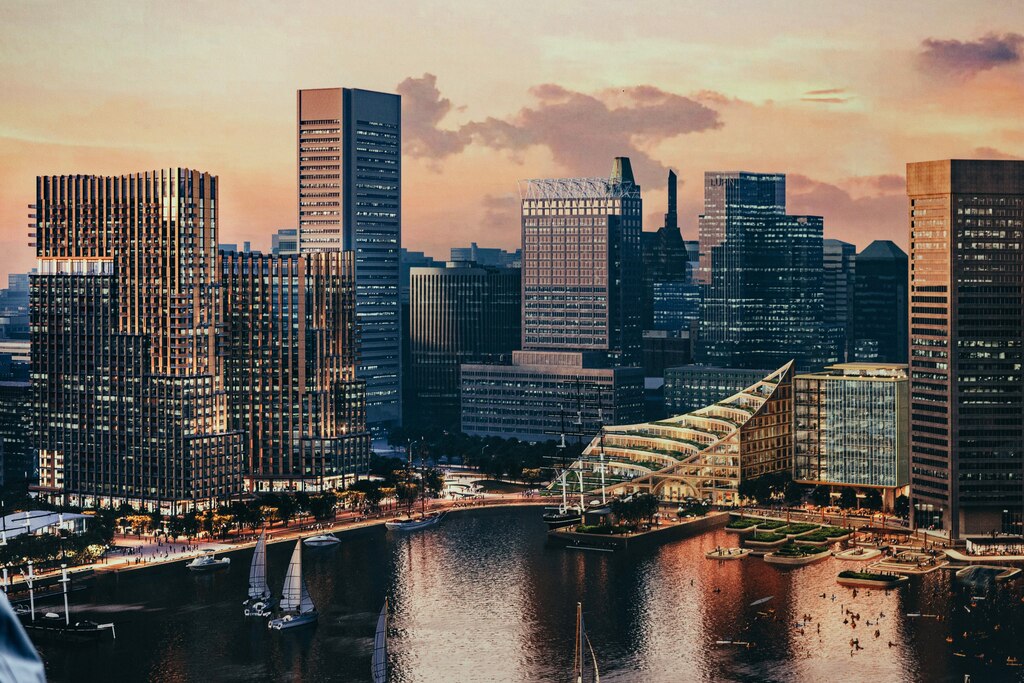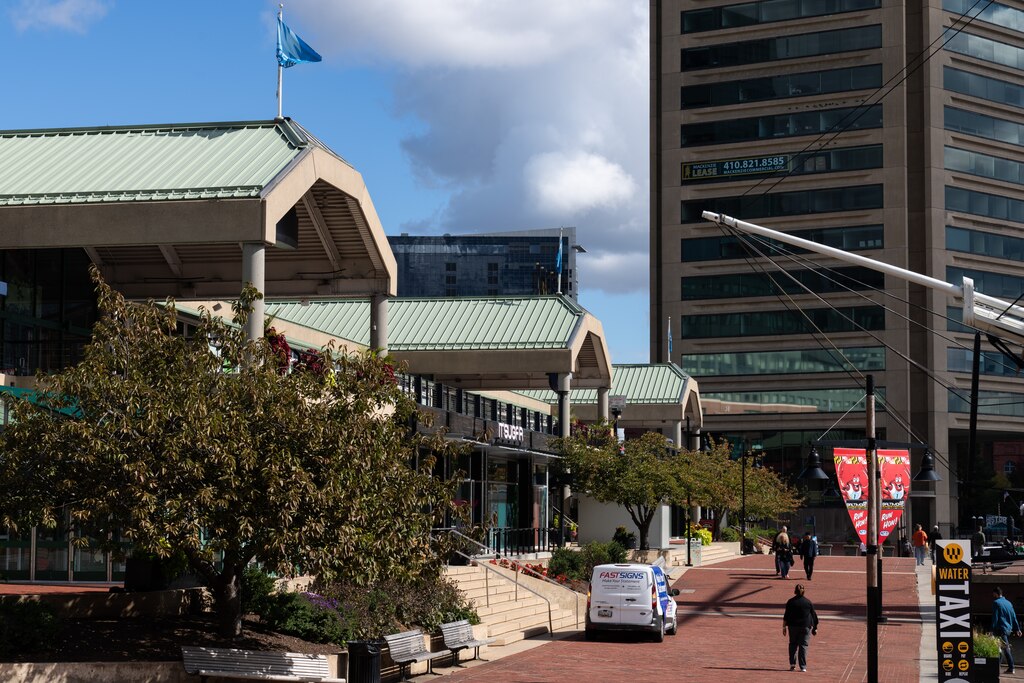The only City Council hearing on the nearly $1 billion proposal to redevelop Baltimore’s prized downtown waterfront stretched for four hours, with elected leaders fielding emotional testimony from backers and entrenched opponents.
Toward the end of the night, Chairwoman Sharon Green Middleton, the council’s vice president, assured attendees that the process for shaping the future of the beloved waterfront destination had only just begun.
City Council’s role in the discussion, though, would not last much longer. The committee took a vote that night, approving the trio of bills to amend land-use requirements along the waterfront with one member opposed. Two weeks later, the full council advanced the package, 13-1, without discussion. If things go similarly Monday night, the package will sail out of City Council and head to the desk of Mayor Brandon Scott, who is expected to sign all three measures.
Baltimore leaders have wasted little time pushing through the bills that would enable MCB Real Estate to move forward with its expensive and disputed vision to rehabilitate Harborplace.
Legislation to change land-use requirements on the publicly owned waterfront was introduced in October and has gone through several rounds of community feedback. But City Council held just one lengthy and contentious hearing, and since then the package has zipped through the legislative body in a matter of weeks with relatively little questioning by elected leaders.
Some economic development watchdogs said city leaders may have squandered an opportunity to more thoroughly assess the project and its costs for taxpayers, which developers say amount to hundreds of millions of dollars.
If City Hall leadership is serious about using its current leverage to gather more information or allow more time for community organizing before construction work gets underway, the council’s quick action is “kind of an own goal,” said Nathan Jensen, a professor at the University of Texas focused on economic development strategies. But maybe this is the approach they want to take, he said, if “they’re just happy to stamp” the project.
MCB’s proposal has had the backing of Baltimore’s most powerful political leaders from the outset. Scott, City Council President Nick Mosby and Maryland Gov. Wes Moore all stood alongside head developer P. David Bramble when he unveiled his firm’s designs. They have cheered the project since then, even as some constituents have decried the designs — particularly plans to build two high-rise residential buildings on city-owned land.
It’s not uncommon for big developers to pressure lawmakers for swift action on legislation they need to move forward, sometimes by leaning on artificial deadlines, Jensen said. In the case of Harborplace, though, MCB Real Estate doesn’t seem to have imposed any such timeline, leaving Jensen puzzled about why City Council has moved as quickly as it has.
“This is, like, bargaining 101,” he said. “You can set the deadline.”

City Councilman Eric Costello, the lead sponsor on the land-use legislation before City Council, declined to comment. MCB spokeswoman Alexandra Hughes said in an email that the only constraint from the developer’s perspective is the State Board of Elections’ late-summer deadline to finalize ballot measure language for November, when city voters will decide whether to allow residential development on Harborplace.
A half century ago, City Council played a different role in the lead-up to the original development of Harborplace under former Mayor William Donald Schaefer. It required an intense lobbying effort by the Schaefer administration to overcome City Council concerns about commercialization of the Inner Harbor and cannibalizing business in other parts of town.
Ultimately, the legislation passed the council on a 12-5 vote in February 1978.
“In December, a majority of the Council was opposed to the plan,” The Baltimore Sun reported at the time, “but the Mayor began exerting his political muscle and the lobbying paid off last night.”
Colin Tarbert, the CEO and president of Baltimore Development Corp., the city’s economic development arm, said the project has followed a typical process for large projects that has also included a more “robust” public engagement element. The waterfront has fallen into a sad state since Schaefer’s Harborplace opened in 1980, and Tarbert said city leaders have encouraged developers to move quickly to revitalize the space and get it on the 2024 election ballot.
A final ribbon-cutting could still be years away, Tarbert said, and the more time that passes the more Baltimore stands to lose.
“How long should it take?” Tarbert said. “There was nothing unusual about the Harborplace process or timeline. I don’t know how anyone could say this process is being pushed faster than anything else, or has had less input or transparency.”
Greg LeRoy, executive director of Good Jobs First, a nonprofit group skeptical of state and local economic development subsidies, said moving quickly can be strategic, depriving opponents of time to organize.
LeRoy argued that taking more time on the front end could allow for a community coalition to negotiate commitments with the developer in the form of a community benefits agreement. That could hold the developer to standards such as green building, local and minority hiring, or partnerships with the city school system.
Baltimore has a long history of favoring investment along city waterfronts over low-income neighborhoods, LeRoy said, but a community benefits agreement is one way of diffusing the benefits of construction and more permanent jobs across the city. The idea that such dealmaking should come after zoning and land-use changes are final is backward, he said.
The suggestion came up during City Council’s lone hearing on the enabling legislation.
In one exchange, Councilwoman Odette Ramos questioned MCB Real Estate attorney Caroline Hecker on the possibility of securing workforce and community commitments from the developer.
“The truth is, it’s a little bit premature for that,” responded Hecker, arguing that those discussions should wait until parcel-level development begins. The city spending board has to vote on amendments to the Harborplace ground lease for development to move forward, a point Hecker said would provide another venue for those discussions.
Ramos, though, argued that City Council would have more leverage now, especially considering the developer has said it has no plans to ask for financial support from the city.
“This is it. This is the opportunity to have those conversations,” said Ramos, who went on to vote in favor of all three bills. “So I just wonder, why hasn’t this conversation even happened yet?”
Councilman Ryan Dorsey, the only vote against the Harborplace bills so far on the 15-member council, met a similar wall when he questioned the Baltimore Department of Transportation on its analysis of the proposed reconfiguration of the Pratt and Light Street corridors, the busy roadways that hem in the Inner Harbor. Corren Johnson, director of the transportation department, noted that the developer will submit a traffic analysis at a later point in the process and said the city hasn’t conducted an assessment of its own.
“There are a lot of moving parts” and “future decisions,” Johnson said.

Tarbert, of Baltimore Development Corp., said a rejuvenated Inner Harbor should have high-rise buildings, residential components and a pedestrian-friendly design: common characteristics in any major metropolitan city. MCB delivered, he said, and spent more time soliciting feedback for the vision than other development firms, including from young people, older adults and neighborhood leaders.
He added that city voters ultimately would have the final say over the matter in November, when they are expected to choose whether to amend the charter to allow for residential buildings at Harborplace — another unique feature that voters haven’t been afforded with other development projects.
“You couldn’t create a more public process than the referendum,” Tarbert said.
Still, the proposal city leaders are expected to greenlight Monday evening is “not a plan,” Dorsey argued. “It’s a superficial vision.”
The Northeast Baltimore councilman supports rehabbing the Harborplace promenade and proposals to make the Inner Harbor more friendly to pedestrians, but he said he has voted against the enabling legislation because he wants to see a government-led effort that doesn’t cede the reins to a private developer.
“There hasn’t been any public leadership on this at all,” he said. “We’re just handing it over.”
Reporter Giacomo Bologna contributed to this story.


Comments
Welcome to The Banner's subscriber-only commenting community. Please review our community guidelines.